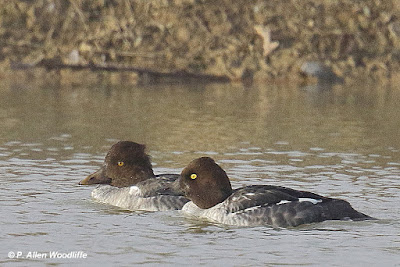It is that time of year, when winter hasn't arrived, the woodlands have few birds in them other than the resident species such as woodpeckers, but the unfrozen wetlands still have birds holding off on the migration.
But a walk through the woods can still be inviting, and there are other things to see such as this rather attractive jelly fungus.
 |
| Fan-shaped Jelly Fungus |
I've been out scouring around to see what I can find, as the Christmas Bird Count season is almost here. Technically today, Dec 15, is the first day of the count period, but most counts, if folks are going through with them, will not likely start until the coming weekend. Social distancing is quite easy to do, and it is healthy to get out and get some fresh air and exercise. The big difference for most, will be not to have any meal and tally gathering at the end of the day.
Some of the local sewage lagoons continue to attract lots of waterfowl. The Ridgetown lagoons have been a good place to check lately, with some less common geese species hanging out. There is always a good number of Canada Geese, but several Snow Geese continue to be there.
...compared to the smaller and much rarer Ross's Goose, which doesn't have the grin patch, has a stubbier bill and if you get the right angle, can see a slightly bluish patch at the base of the bill.
Lots of Tundra Swans are coming and going.
There is usually a good variety of ducks, but often many of them are on the far side of the far pond and difficult to get a good close-up photo of. These two Common Goldeneye were in the closest pond.
Sandhill Cranes have become much more common in recent years, but at this fairly late date, most have continued on with their migration. A few groups are still around, such as this one that I 'shot' today up near the Bear Creek Unit of St. Clair NWA.
Snowy Owls are showing up and sticking around, and hopefully will continue to do so for the upcoming bird counts. They seem to be particularly fond of staying well away from roads, so getting a photo at a distance seems to be the only option most times.
The usual mix of other raptors are scattered around, with the most common one being Red-tailed Hawk.
Rough-legged Hawks are much less common, and the dark phase of this species, shown in the next two photos, is even less common than the light phase.
There will likely be at least a few Northern Harriers around all winter, but they are difficult to photograph. I got this one at quite a distance. Fortunately its white rump is fairly visible.
I was actually on my way to a spot along Stefina Line, south of Blenheim, which periodically has one or more Short-eared Owls, when the Northern Harrier flew by. A bit later I arrived at the large pasture, which has a combination of short grass, some longer and weedier grass and some shrubby trees. As long as the habitat was good for a healthy mice or voles population, it would be good for raptors. I met up with three other people who were also on the lookout for the owls. The Short-ears don't seem to fly during nice daylight, but more often just at dusk. On this heavily overcast day, there was nothing moving, so two of the others left. It was tempting to leave as well, but I figured I was here, why not wait just another few minutes. And then one appeared, albeit briefly, as it flew up from the dark background and its round head and floppy flight was quite evident against the fading sky. There was no real opportunity to get a photo, so I just enjoyed the brief view with binoculars. The image below shows a Short-eared Owl at this same location taken several years ago, when one decided to show itself in much better light conditions and cooperated nicely at least for a few minutes.
















Loved the brightly coloured jelly fan, seasonal decoration to cheer up the winter days. Have a wonderful Christmas, we'll be thinking of you with love.
ReplyDeleteHi Paula. Indeed the jelly fungus is a bright spot in an otherwise dull-colored landscape. All the best to you this season!
Delete